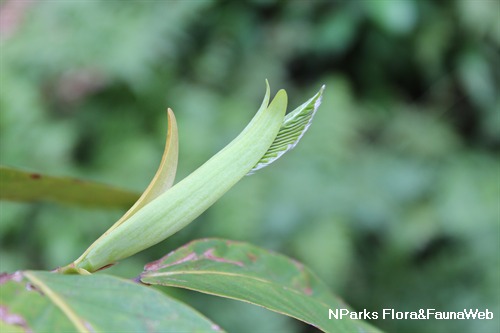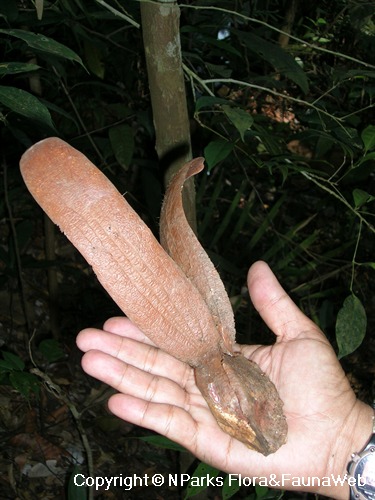
Back
Dipterocarpus fagineus
| Family Name: | Dipterocarpaceae |
| Synonyms: | Dipterocarpus pseudofagineus |
| Common Name: | Keruing pipit, Keruing kelabu |
Name
Classifications and Characteristics
| Plant Growth Form | Tree |
|---|
Biogeography
| Native Distribution | Sarawak, Malaysia |
|---|---|
| Native Habitat | Terrestrial |
| Preferred Climate Zone | Tropical |
Description and Ethnobotany
| Growth Form | A large tree with grey trunk. |
|---|---|
| Trunk | Bark is lenticellate and shed in large flakes. |
| Foliage | Leaves of Dipterocarpus fagineus are elliptic-lanceolate (about 15 cm long and 7.5cm wide) that is shortly acuminate or blunt with 10 – 15 pairs of lateral veins. Leaves are glabrous but the underside is covered with a whitish coating. Stipules are narrow (10 cm long) and turning pale yellow before they fall. |
| Fruit | Calyx tube is elliptic (about 1.5cm long) with prominent ridges or angles running almost to the pointed base. Fruit comprises of 2 long wings (about 8cm long) which is non-hairy and 3 nerved. The remaining 3 wings are inconspicuous. |
| Habitat | Occur in coastal hill dipterocarp forest and hill forest, ranging from 200m to 1000m. |
| Etymology | Dipterocarpus is from Greek words "dipteros" which means "two-winged" and "karpos" which means "fruit" and they refer to the character of the fruit. Species fagineus is a latin word which means beech-like, referring to the resemblance of the Keruing pipit’s grey trunk to a beech tree trunk. |
Landscaping Features
| Landscape Uses | Suitable for Roadsides, Parks & Gardens |
|---|
Plant Care and Propagation
| Light Preference | Full Sun |
|---|---|
| Water Preference | Moderate Water |
| Plant Growth Rate | Moderate |
| Propagation Method | Seed |
Foliar
| Foliage Retention | Evergreen |
|---|---|
| Mature Foliage Colour(s) | Green |
| Foliar Type | Simple / Unifoliate |
| Foliar Attachment to Stem | Petiolate |
Non - Foliar and Storage
| Mature Bark Texture | Lenticellate |
|---|---|
| Root Type | Underground |
Image Repository
Others
| Master ID | 29652 |
|---|---|
| Species ID | 3961 |
| Flora Disclaimer | The information in this website has been compiled from reliable sources, such as reference works on medicinal plants. It is not a substitute for medical advice or treatment and NParks does not purport to provide any medical advice. Readers should always consult his/her physician before using or consuming a plant for medicinal purposes. |




_lowres.jpg)


